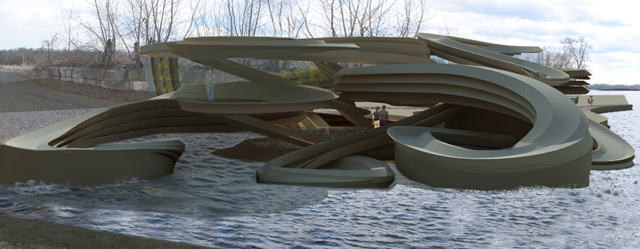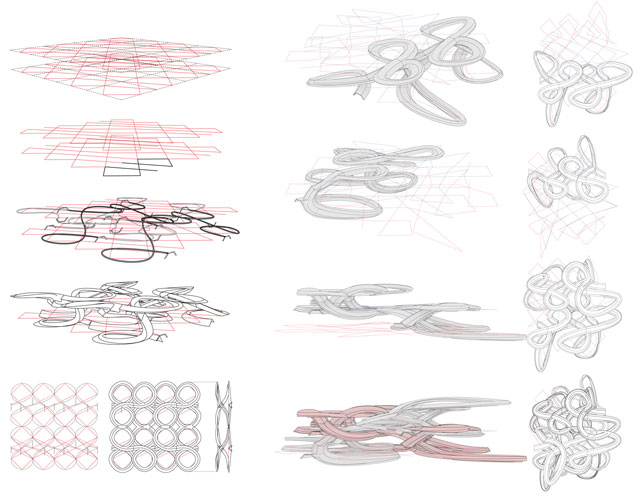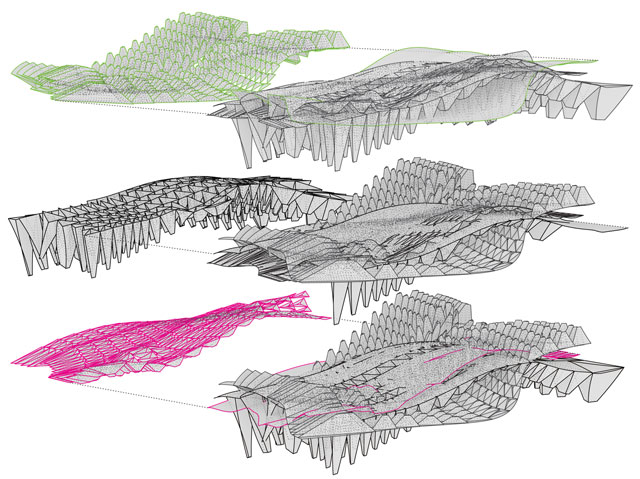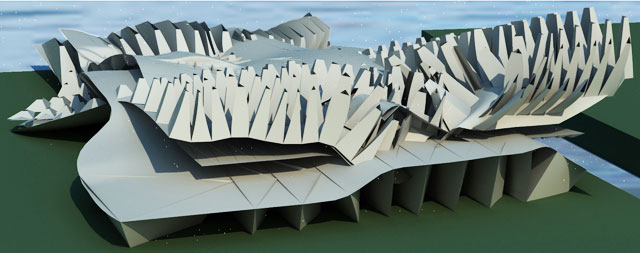FP Carvalho Section 12-13
Final Project | Jeremy Carvalho, Adjunct Professor
STANDARD DEVIATION:
Bio-Industrial Infrastructure
FP Students 2012-13 – Carvalho Section

Premises:
Could an architectural approach to systems design create a catalytic series of relationships among natural resources and industrial production?
To what extent can a ‘constructed ecology’ harness or facilitate manifold processes of energy production & consumption?
What prototypes of new, hybrid ‘infra-structure’ can be produced by considering the built environment on a more ecological basis?
How can generative & parametric design logics be deployed to explore and develop the foregoing design relationships?

Siting:
Water resources and transportation networks have long served as catalysts for industrialized activity and related growth of the cities lining the Hudson River valley. Infrastructural development has played various roles in development, as transport hubs for food commodities and industrial production have also catalyzed industry and sustained growth in the past. Steel and textile industries supported architectural experimentation at the turn of the century that is still visible in the breadth of steel and masonry construction traditions preserved in many area downtown historic districts. Current economic development plans often suggest creating local or regional centers for high-tech companies while developing program to suit or attract these companies. RPI for example also supports a wide range of technology transfer initiatives and has vested interests in regional development. Given this background potential, proposing the re-invigoration of industry + landscape might emphasize innovative processing of natural resources and energy / natural resource production. By taking advantage of existing river-to-street frontage and transport / trade infrastructure, the development of alternative industries with new connections to regional growth may be possible. Additionally, the challenge of re-thinking fundamental relationships among urban culture, transport / trade infrastructure and organic process / production frames an important set of issues for integration with thesis design research.
Parallel Processing:
Design research will focus upon developing conceptual and technical strategies that can modulate environmental resources, industrial / agricultural program and dynamic site relationships. Design methodologies will simultaneously explore potentially unique combinations of parametric geometries, structural systems, and advanced environmental strategies that can take advantage of material flow & site resources while proposing new forms of activity for dynamic regional landscape conditions. Research models will be developed through parallel investigations of the following ‘design research scaffolds’:
- Models of Organization: Design research will construct ‘standard catalogs’ of structural and geometric systems through the design lens of environmental parameters. These parameters will help form an investigative, experimental design logic for combining environmental response and horticultural / material processing program as generative ‘deviations’ from original systems, whether through accretion, catalysis, or feedback loops within the various system components of projects.
- Environmental Morphology: Initial analysis / research will be organized into at least four group categories; “Solar Ecologies, Hydro-Ecologies, Biomass Systems, and Aerodynamic Systems.” Each category will help define environmental design parameters impacting design morphology and methodology at an organizational level as well as set up experimental tests of ‘deviation’ upon structural substrate systems.
- Substrate / Landscape: A ‘Substrate / Landscape’ approach will apply to the capacity of various form- or surface-active structural systems to act as scaffolding and growth media for organic processes, material / energy flow and industrial processing while at the same time modulating the fluid boundaries of ‘interior / exterior’ or ‘natural / artificial’ site conditions.
- Systems Integration: Design studies will coalesce around unique combinations and unique relationships among building systems rather than strictly formal or programmatic relationships. Because industrial program, innovative environmental strategies and structural substrates offer myriad opportunities to modulate environment rather than simply exclude or contain it, projects will attempt to re-conceptualize performance as a series of integrated processes – as conduits for material and resource flow.
“Standard Deviation”
“Standard Deviaton” in studio context refers to the variability of structural ‘substrate’ and environmental strategies when engaging river’s edge or other dynamic environmental conditions. The term also conceptualizes the unique but holistic parametric ‘adaptation’ occurring in projects when ‘deviating’ or carefully altering standard structural & system design typologies. By examining the ideas of a ‘productive landscape’ according to parallel but unique topological and organizational constraints outlined above, each project will attempt to both integrate and challenge structural, environmental and organizational ‘norms’, or ‘standard models’ of design.


///